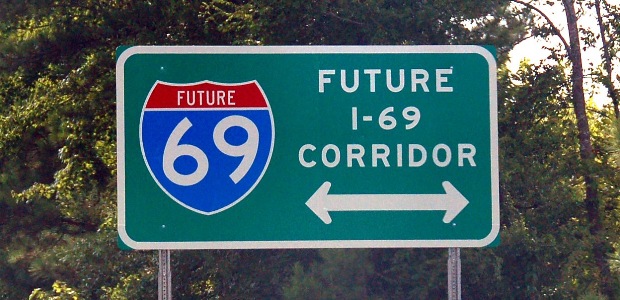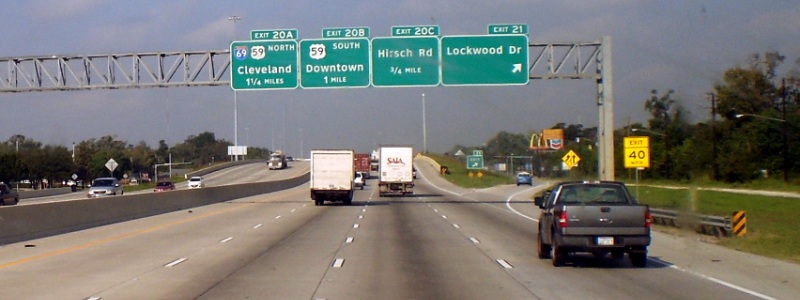 |
|
|
| Interstate 69 is an
Interstate Highway (ih) that is in the process of being
built in the U.S. state of Texas. It is part of a longer
i69 extension known as the NAFTA Superhighway, that,
when completed, will connect Canada to Mexico. In Texas,
it will connect Tenaha and Interstate 69 in Louisiana at
the Louisiana border through the eastern part of the
state and along the Gulf Coast to Victoria, where it
will split into three branches: i69E to Brownsville,
i69C to Pharr, and i69W to Laredo. The first segment of
i69 in Texas was opened in 2011 near Corpus Christi. The
American Association of State Highway and Transportation
Officials (AASHTO) approved an additional 53 miles of US
77 from Brownsville to Raymondville for designation as
i69, which was to be signed as i69E upon concurrence
from the Federal Highway Administration (FHWA). FHWA
approval for this segment was announced on May 29, 2013.
By March 2015, a 74.9 mile section of US-59 had been
completed and designated as i69 through the Houston
Metropolitan Area. As of 2021, short segments near the
southern termini of the three branch routes have also
all been completed. |
|
|
| The congressionally
designated i69 corridor begins at the Mexican border
with 3 auxiliary routes: |
|
|
|
|
I69W begins at the
entrance to the World Trade International Bridge, which
connects to Mexican Federal Highway 85D (Fed. 85D), near
the border in Laredo. It is co-signed with both US 59
and Loop 20 (Bob Bullock Loop) and extends 1.4 miles to
I-35 (which connects to Fed. 85 south of the border). It
will continue on US 59 east to George West, where it
will intersect i69C, it will then intersect i37 east of
George West, and it will then continue east to Victoria.
|
| |
| I69C (with connections
to Fed. 97) begins in Pharr at i2 and is designated for
18 miles through Edinburg and co-signed with US 281. It
will continue north along US 281 to George West, where
it will intersect i69W and terminate at this point. |
| |
| I69E begins just north
of the Veterans International Bridge, which connects to
both Fed. 101 and Fed. 180, near the border in
Brownsville and continues for 53.3 miles through Olmito,
where it intersects i169 and through Harlingen, where it
intersects i2 and past Raymondville and co-signed with
US 77, it is also co-signed with US 83 from Brownsville
to Harlingen. The route will follow the US 77 corridor
north to Corpus Christi, where a 7.8-mile segment is
already designated as i69E and co-signed with US 77 and
also intersects i37, and it will then continue north to
Victoria. |
|
|
| I69W and i69E will merge
just south of Victoria, Texas, where mainline i69 will
follow US 59 northeast to Fort Bend County. In the
Houston area, i69 follows US 59 (Southwest Freeway) from
Fort Bend County to the west loop of i610. I69 then
follows US 59 (Eastex Freeway) from the north loop of
i610 to the Liberty-Montgomery county line. The segment
of US 59 inside Loop i610, through downtown Houston, was
approved for designation as i69 by the FHWA on March 9,
2015 and approved for signage as i69 by the Texas
Transportation Commission on March 25, 2015. |
|
|
| I69 will follow US 59 to
the north, serving Cleveland, Shepherd, Livingston,
Lufkin, Nacogdoches, and Tenaha. In Tenaha, i69 will
head into Louisiana along the US 84 corridor. The
segment of US 59 from Tenaha to Texarkana will be signed
as i369. |
|
|
| Since the first section
of US 77 between Corpus Christi and Robstown was signed
as i69, it implied that the i69 mainline would follow
the coastal (US 77) route from Victoria to Brownsville.
This also implied that the branch along US 59 from
Victoria to Laredo and the branch along US 281 from
George West to Pharr would be signed as either
three-digit spurs of i69 or as separate two-digit
Interstate Highways. While federal legislation
designating the south Texas branches as i69 suggested
that these routes may be designated as "i69E" (east,
following US 77), "i69C" (central, following US 281),
and "i69W" (west, following US 59), the American
Association of State Highway and Transportation
Officials Special Committee on Route Numbering rejected
the Texas Department of Transportation's request for
these three designations along the proposed i69
branches, citing that AASHTO policy no longer allows
Interstate Highways to be signed as suffixed routes.
Stating that the i69E, i69C, and i69W designations for
the three i69 branches south of Victoria were written
into federal law, the initial denial of TxDOT's
applications were subsequently overturned by the AASHTO
Standing Committee on Highways, and the approval for the
i69E, i69C, and i69W branch designations were confirmed
by the AASHTO Board of Directors, pending concurrence
from the Federal Highway Administration during the
AASHTO Spring Meeting on May 7, 2013. During this same
meeting, the section of US 83 between Harlingen and
Penitas was conditionally approved to be designated as
i2, with FHWA concurrence. The US 83 freeway in south
Texas was widely anticipated to receive an i69
designation instead of I-2. In any case, Texas is
proceeding in the same fashion as Indiana, conducting
environmental studies for its portion of i69 in a
two-tier process. The mainline route through Texas will
be approximately 500 miles. On June 11, 2008, TxDOT
announced they planned to limit further study of i69 to
existing highway corridors (US 59, US 77, US 84, US 281,
and SH 44) outside transition zones in the lower Rio
Grande Valley, Laredo, Houston, and Texarkana. |
|
|
|
Texas originally sought a public-private partnership to
construct much of the route through Texas as a privately
operated toll road under the failed Trans-Texas Corridor
project. However, on June 26, 2008, TxDOT announced that they
had approved a proposal by Zachry American and ACS
Infrastructure to develop the i69 corridor in Texas, beginning
with upgrades to the US 77 corridor between Brownsville and i37;
the Zachry/ACS plan calls for the majority of the freeway to be
toll-free; the only two tolled sections would be bypasses of
Riviera and Driscoll. |
|
|
| Original plans for the route included a
potential overlap with the "TTC-35" corridor component as well,
but the preferred alternative for that component follows i35
south of San Antonio instead of entering the lower Rio Grande
Valley. |
|
|
 |
|
|
|
Route 59 in Houston |
|
|
 |
|
|
|
